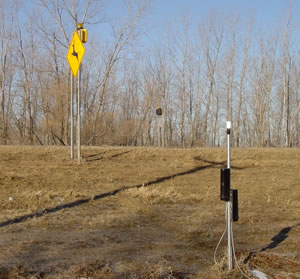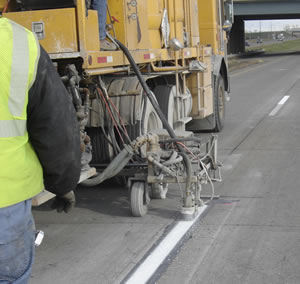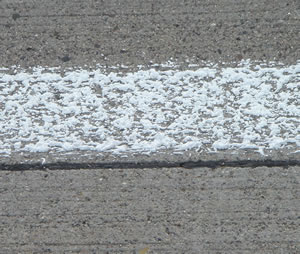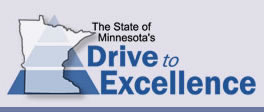 |
 |
|
 |
Test will show how well roadside beacons reduce deer-vehicle crashes |
 |
 |
 |
|
Light beam generators (foreground) relay the beams from sign to sign and activate flashers on top of the signs when a deer breaks the beam. The generators and signs with beacons are spaced from 30 to 60 feet apart. Photo by Bob Weinholzer |
A two-mile section of Hwy 23 southwest of Marshall presents an ideal location to test Mn/DOT’s latest effort to reduce the number of deer-vehicle crashes.
The western side of the highway borders Camden State Park and an adjacent wildlife management area, making it a good environment for deer. On the eastern side, the roadway skirts field after field of corn.
Hence, there are a lot of deer crossing the highway and a high number of crashes involving deer and vehicles.
On a recent trip to the site, Bob Weinholzer, a program administrator with Traffic, Security and Operations, saw two deer carcasses in the two-mile section of Hwy 23. Ironically, one deer was found laying just a few feet from a standard deer crossing warning sign.
Come spring, however, 21 of the signs will be fitted with solar cell collectors that power beams of light between each sign post and trigger flashing beacons to warn motorists that deer are in the roadside area. The solar panels convert sunlight into electricity. Batteries will provide a three-day energy reserve in case of inadequate sunlight. Underground cables will connect the system.
When a deer breaks the light beams, the system signals the beacons to flash on the signs facing the driver, Weinholzer said.
The system uses two light beams: one is 29 inches above ground, the other is 35 inches above ground. Using dual beams, he said, helps ensure the animal breaking the beam is the size and density of a deer. Weinholzer said it’s unlikely that a bird, for example, would trip the signal. He said the beams are also unaffected by rain and snow.
The effort to reduce deer-vehicle crashes stems from Minnesota’s number of incidents and a growing fatality rate. In 2004, Minnesota experienced nearly 5,000 crashes. The crashes caused eight deaths, three more than the five reported annually for 2001-03.
Weinholzer said that, according to an insurance company, Minnesota ranks sixth among states in the number of deer-vehicle crashes. Pennsylvania and Michigan head the list.
He adds that the number of crashes in Minnesota will continue to increase due to development in previously wooded areas and the absence of predators when housing replaces forested or other natural areas.
“We hope this method will prove successful and help us reduce the number and severity of deer-vehicle crashes,” he said.
By Craig Wilkins
|
back

|
 |
Season’s first snowstorm brings dozens of crashes, including one involving Mn/DOT snowplow |
 |
 |
The season’s first storm brought wind, rain, snow and a crash involving a Mn/DOT snowplow from the Metro District that injured a veteran snowplow operator.
A semitrailer truck traveling at full speed rear-ended a Mn/DOT snowplow on southbound Interstate 35 in Burnsville at about 5 a.m. on Nov. 16, according to Kent Barnard, a Metro District public affairs coordinator. The snowplow was spreading sand and salt at the time, and traveling about 25 miles per hour with its warning lights on.
The driver of the semitrailer truck suffered serious injuries in the crash. Dale Cody, a transportation generalist at the Lakeville Truck Station who was operating the Mn/DOT vehicle, was treated and released with minor injuries, Barnard said.
The Minnesota State Patrol reported numerous storm-related incidents statewide including injury crashes, stalled vehicles and scores of vehicles that veered off the road.
Mn/DOT’s annual effort to alert the public about the hazards associated with winter driving and the need to give snowplows extra room started during the week of Nov. 1.
The messages stress the need to give snowplow operators extra room, drive according to road and weather conditions and stay alert, especially when driving near snowplows.
Barnard joined Kevin Smith of the Department of Public Safety in urging drivers to slow down, use extra care and to stay alert for snowplows.
For tips on safe winter driving, go to Mn/DOT’s Web site at http://www.dot.state.mn.us/workzone/.
By Craig Wilkins
|
back

|
 |
Visible when wet: New pavement markings promise improved reflectiveness in rain, darkness |
 |
 |
 |
|
A work crew installs Pathfinder, an experimental wet-reflective material, on Hwy 610 in Brooklyn Park. Photos courtesy of Office of Traffic, Security and Operations
|
On rainy nights, motorists on Hwy 610 in Brooklyn Park will be able to guide their vehicles more confidently by using experimental lane markings.
The experimental markers are also installed on a newly reconstructed section of Interstate 94 between Evansville and Dalton in District 4 and on a section of Ramsey County Road 96 in Vadnais Heights.
The new pavement markers shine when the sun doesn’t—when it’s dark and when it rains.
Maggi Chalkline, state pavement marking engineer with the Office of Traffic, Security and Operations, said the new markings comprise a field test to determine which work most effectively.
“Typically, Mn/DOT pavement markings have glass beads imbedded in the surface that are retroreflective—they have the ability to reflect light back at its source, such as reflecting headlights back to a driver,” she said.
Chalkline said, however, that most pavement markings lose this ability when wet because water on top of them scatters and bends the light beams.
The new products, she said, use texture to raise the markings out of the water and special elements that compensate for distorting the light beams. Staff from Traffic, Security and Operations and the Office of Maintenance worked together to set up the study that will determine which of the new markings performs best in the field.
 |
Applied as a liquid plastic, Pathfinder begins to harden after installation.
|
The testing will evaluate three new marking materials, Chalkine said. The first, known as Glomarc 90, uses an epoxy liquid and adds specially configured glass beads and bead clusters to improve retroreflectivity when roads are wet.
The second, called Pathfinder, employs a liquid plastic which hardens into a textured marking material imbedded with glass beads.
The third, known as 380 I ES wet reflective tape, is a specially textured, pre-formed plastic tape also containing glass beads.
The materials are installed in grooves as much as 1/10 of an inch deep. Recessing the materials slightly reduces the effects of being worn or scraped away by snowplows, Chalkline said.
The experimental materials are installed side by side with each other and with newly placed markings that use Mn/DOT’s standard epoxy paint for ease of comparison.
The field tests also will evaluate the durability of each material to enable managers to choose the most cost-effective method. In addition to visual observation, Traffic, Security and Operations staff will also use a laser that measures retroreflectivity during the testing period. Results from the tests will be posted on the Traffic, Security and Operations Web site.
“The field tests will show which of the three materials is most visible under all conditions long term as well as evaluate durability, cost and installation issues. A successful outcome to this would be for Mn/DOT to find a cost-effective marking that will be visible under more conditions (rainy nights) than our current pavement markings,” Chalkline said. “And the testing will help Mn/DOT meet its safety goals.”
By Craig Wilkins |
back

|
 |
Halvorson leads interagency transit coordination committee |
 |
 |
A committee to foster the coordination of health- and human services-related transportation in the state was created in September by Gov. Tim Pawlenty. Leading the state’s Interagency Committee on Transit Coordination is Mn/DOT’s Randy Halvorson, Program Management Division director.
The committee’s charge is two-fold. The panel will survey existing transportation alternatives, best practices and coordination methods that have worked in Minnesota and other states. In addition, the committee will develop recommendations to improve coordination levels in the state.
Health and human services agencies provide a variety of transportation systems and the state invests significantly in public transit. However, the delivery of these services is often fragmented or duplicated.
Halvorson said the committee enables agencies to work together to find ways to provide transportation services effectively while making the most of transit resources.
Creation of the state committee parallels formation of the federal Interagency Transportation Coordinating Council created by President Bush in 2004. His executive order directed federal agencies to work together to ensure that transportation services are made more comprehensive and more accessible.
Joining Halvorson on the panel are representatives from the Center for Transportation Studies, the Metropolitan Council, the Minnesota Board on Aging, the Minnesota State Council on Disabilities and the state departments of Human Services, Health, Education and Employment and Economic Development.
The committee will provide the governor with recommendations on Nov. 1 of each year.
|
back

|
 |
November newsletter of Drive to Excellence initiative now online |
 |
 |
 |
|
The November issue of “The Excellence Report,” the state’s Drive to Excellence newsletter, is now online. |
The November issue of “The Excellence Report,” the state’s Drive to Excellence newsletter, includes an interview with Gopal Khanna, state chief information officer; an update on the Enterprise One-Stop Licensing vendor forums held in mid-October, and highlights from the six Drive to Excellence projects (Licensing, Information Technology, Governance, Building Codes, Real Property, Sourcing and Grant Management).
Click here to read the current and past issues of “The Excellence Report.”
|
back

|
 |
|
 |



